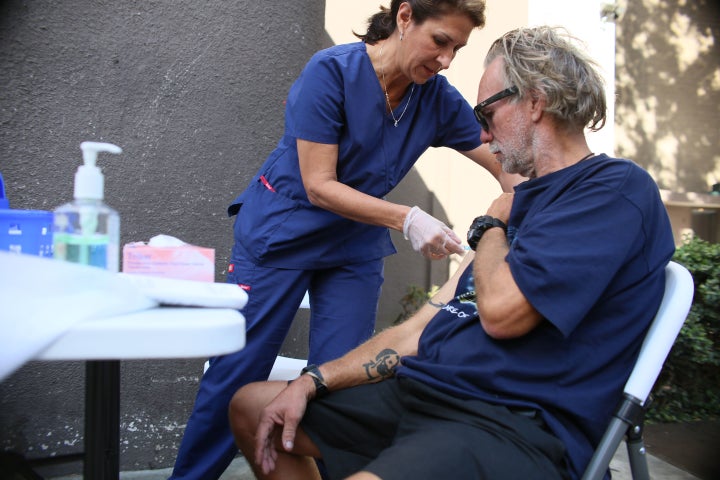
A severe but localized hepatitis A outbreak in San Diego last fall has morphed into outbreaks across multiple states ― the latest arising in Missouri, Kentucky and Indiana ― with no signs of the virus slowing down.
Cases of hepatitis A in the United States have nearly doubled since this time last year, even as public health officials have worked to stem the tide of infections through vaccine campaigns and community education.
Now, the U.S. Centers for Disease Control and Prevention has issued an emergency alert to local and state public health officials nationwide, warning of the sharp rise in hepatitis A cases and the potential for outbreaks in their jurisdictions.
The CDC reports that 68 percent of the cases over the last year and a half that are linked to the ongoing outbreak are among people who are homeless, use illicit drugs or both.
While hepatitis A outbreaks are common in countries without proper sanitation systems and outbreaks among large homeless populations have occurred in other countries, the pattern of this outbreak is unprecedented in the U.S. in recent years. Since the licensing of a hepatitis A vaccine in 1995, the U.S. has typically just seen cases associated with contaminated imported food.
This year’s numbers are on track to significantly surpass last year’s total of 2,984, with 1,772 cases as of June 2 and seven more months to go. Public health experts fear that hepatitis A outbreaks are now a nationwide problem that will cost local and state health departments millions of dollars to control.
What’s particularly tragic is that these outbreaks could have been prevented with vaccines, said Laura Hanen, interim executive director and chief of public affairs for the National Association of County and City Health Officials.
“No one should have to get hepatitis A,” Hanen said.
See How It Spreads
On Aug. 25, 2017, the CDC notified all public health departments about its investigation into a cluster of hepatitis A, genotype IB infections in people who are homeless, use injection and/or non-injection drugs, or both, according to Dr. Monique Foster, an epidemiologist in the CDC’s viral hepatitis division. Around the same time, San Diego County declared a public health crisis due to a hepatitis A outbreak that has thus far infected 589 people and killed 20 in the county.
Last fall, San Diego County began washing its streets with bleach, handing out sanitation kits and adding public handwashing stations. It began an aggressive vaccination campaign that reached out to the homeless and drug-using populations on the streets. On Jan. 23, the local public health emergency was declared over as the hepatitis A case count had slowed dramatically.
But by then, other communities across the country were fighting their own battles.
Nearby California cities with similar homeless populations and conditions, including Santa Cruz and Los Angeles, saw spikes in hepatitis A during the summer and fall. Infections followed in Salt Lake City and urban areas in Arizona and Colorado.
Michigan was also battling its own outbreak. After starting in the southeastern part of the state in and around Detroit, cases spread throughout Michigan, well beyond urban areas. Michigan eventually surpassed California’s outbreak with a total of 840 cases and 27 deaths ― and counting.
Kentucky’s outbreak, which was only declared in November, now has 455 cases and 3 deaths and has moved beyond Louisville into other parts of the state. In Missouri, which has seen 116 cases this year, the challenge has been reaching the rural populations where the outbreak is spreading, said Megan Hopkins, head of the public information office at the Missouri Department of Health and Senior Services.
“It’s extremely hard to stop. I think it’s only going to continue to get bigger.”
- Jonathan Ballard, formerly Kentucky's state epidemiologist
Genotyping of the virus has linked the San Diego outbreak with outbreaks in Arizona, Indiana, Kentucky, Utah and West Virginia, according to Foster, while Michigan is fighting a different hepatitis A, genotype IB strain.
Ultimately, the number of cases in 2017 was 48 percent higher than in 2016, with an adjusted case count of 2,984, according to HuffPost analysis.
The latest CDC alert, which was issued Monday, notes that hepatitis A can be spread by “contaminated needles and other injection paraphernalia, specific sexual contact and practices,” and “generally poor sanitary conditions.”
Among the most affected populations, “transience, economic instability, limited access to healthcare, distrust of public officials and public messages, and frequent lack of follow-up contact information” are making the outbreaks “difficult to control,” the CDC added.
Many homeless people and illicit drug users are also too old to have been among the wave of children vaccinated after the licensing of the vaccine in 1995. The CDC recommends that all children receive the vaccine, and it is required to attend school in some states.
Dr. Jonathan Ballard, who served as Kentucky’s state epidemiologist in the early months of the outbreak there (until he started as a professor at Dartmouth two weeks ago), offered his own ominous warning.
“It’s extremely hard to stop,” he told HuffPost, referring to hepatitis A’s potential spread into Appalachia, which is already battling the opioid epidemic. “I think it’s only going to continue to get bigger.”
A Symptom Of Twin Crises
In searching for answers as to why these outbreaks are happening now, some experts point to the ongoing opioid epidemic ― which kills 115 people each day in the U.S. ― and the increasing numbers of homeless people as key drivers. And homelessness and drug use are often intertwined. Experts say both are also linked to unsanitary environments, which can increase the risk of transmission through fecal matter. They just differ on which factor they blame more.
In Kentucky, the reason for the massive spike is clear to Ballard. “The outbreak is a symptom of the opioid epidemic,” he told HuffPost. “I don’t know how you can say it’s not.”
Some are a bit more hesitant to focus exclusively on the explosion in opioid use. Jay Fiedler, manager of the surveillance and infectious disease epidemiology section at the Michigan Department of Health and Human Services, noted that opioids are not the only drugs out there.
Take Missouri, where the latest cases have occurred primarily among drug users. The drug of choice there is methamphetamine, according to Hopkins.
But even Fiedler said the opioid epidemic and hepatitis A outbreaks are correlated.
The CDC’s Foster made a similar observation in an email: “A significant proportion of the people with hepatitis A report injection and non-injection drug use in areas heavily affected by the opioid crisis, including Kentucky and West Virginia. However, they also report using a variety of drugs other than opioids.”
Sen. Bill Cassidy (R-La.) ― who was a doctor specializing in diseases of the liver, like viral hepatitis, before running for Congress ― agrees.
“I can guarantee you if we took care of the drug epidemic, a lot of this would go away,” he said.
On Tuesday, the House passed a bill sponsored by Rep. Leonard Lance (R-N.J.) that would give the CDC more money to combat infectious diseases on the rise due to the opioid epidemic ― including hepatitis A. The measure now moves to the Senate.
“If we aren’t thinking about this long term, then we’re destined to repeat this down the road.”
- Jay Fiedler of the Michigan Department of Health and Human Services
Dr. Jeff Duchin, the public health officer for Seattle, suspects that homelessness is more likely to blame for the latest outbreaks. His city has not yet seen a hepatitis A surge, but in nearby California, homelessness has been more common among patients than drug use.
Inadequate affordable housing, health services and access to economic opportunities set the stage for infectious diseases to take root in communities, Duchin said, making the rise in hepatitis A “only one symptom of the homelessness crisis.”
“Unless we solve the underlying problem, there will be others that continue,” he said.
Hanen of the National Association of County and City Health Officials echoed that logic, arguing that while some of this is definitely driven by the opioid epidemic, homelessness is likely the root cause.
“We have a lot of work to do in terms of homelessness in this country and in terms of providing clean access to bathrooms and sanitary conditions. ... Particularly in expensive urban areas, affordable housing continues to be a larger issue,” she said.
The Doctors’ Most Important Tool
As the hepatitis A outbreaks worsened at the end of last year, the need for the vaccine outpaced the supply, and the CDC was forced to funnel vaccines primarily to states battling outbreaks. Vaccine producers have since caught up, but the CDC and manufacturers are still monitoring vaccine usage closely, according to Foster.
“Vaccination is the most important tool we have to stop hepatitis A outbreaks,” she said. “Everyone at risk should be vaccinated.”
Officially, the CDC has encouraged state and local health departments to vaccinate people at high risk ― primarily the homeless or drug-using populations ― and those who interact with people at high risk.
Cassidy couldn’t agree more on the importance of vaccines in preventing viral hepatitis. As a physician back in Louisiana, he’d set up a vaccination program aimed at hepatitis B after treating a patient who could have avoided hundreds of thousands of dollars in medical bills with a $50 vaccine.
The senator noted the cost savings of administering vaccines as opposed to fighting a full-fledged outbreak.
But as Cassidy pointed out, “The thing about public health is no one appreciates that which doesn’t occur.”
“No one should have to get hepatitis A.”
- Laura Hanen of the National Association of County and City Health Officials
While the hepatitis outbreaks have captivated local news stations in cities with ongoing outbreaks such as Louisville, national media attention has been scarce, said Fiedler, the Michigan health official.
“We live in a 24-hour media cycle world, and we haven’t been able to penetrate in terms of the importance of this,” Hanen agreed.
Attitudes toward drug users and the homeless may contribute to the lack of public attention. “I think people have a tendency to pay more attention to this when it strikes home,” Duchin said. “Many people don’t feel as engaged when they can’t relate to the population who is suffering.”
The Potential For Worse
The latest CDC alert warned all health departments to be on the lookout for those with the symptoms of hepatitis A, which include fever, fatigue, loss of appetite, nausea, vomiting, abdominal and joint pain, and jaundice. The disease has a long incubation period so those symptoms may show up weeks after infection ― which is another reason hepatitis A is difficult to contain.
The alert also called for “rapid identification, a comprehensive response, and novel public health approaches” as well as “urgent action” to stop transmission of the infection.
The need to embrace new approaches ― such as reaching out to needle exchange clinics and homeless shelters ― and to learn from the current situation is something that Fiedler stressed.
“We have to be thinking about are these activities that we can maintain, how can we maintain them and how can this become better integrated into a part of our routine public health service delivery,” he said. “If we aren’t thinking about that and if we aren’t thinking about this long term, then we’re destined to repeat this down the road,” he added.
Duchin constantly worries about the outbreak spreading to Seattle, which has the country’s third-largest homeless population. But his fears likely echo with public health officials elsewhere.
“I think we are very vulnerable, and the conditions are ripe here to allow hepatitis A to spread.”
